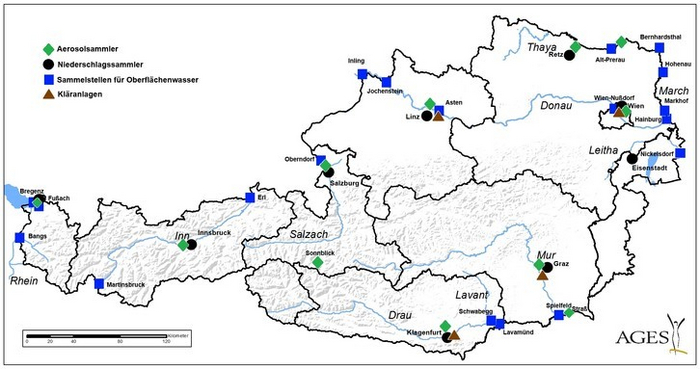Nuclear emergency response
The safety of the peaceful use of nuclear energy has been a much-discussed topic for decades. While Germany has decided to phase out nuclear energy by 2022, new nuclear power plants are being planned in other countries. What is certain, however, is that the consequences of an accident can be devastating, as the Super-GAUs (Greatest Assumable Accident) of Chernobyl on April 26, 1986 and Fukushima on March 11, 2011 have shown. Since radioactive clouds know no national borders, Austria is also potentially at risk. Therefore, conscientious emergency planning and the implementation of measures are absolutely necessary in order to keep the impact on the population as low as possible in the event of a radiological emergency.
International nuclear emergency response
After the Chernobyl nuclear disaster, international agreements were reached that require states to inform the international community in the event of a possible imminent release of radioactivity. This advance warning period enables affected states to prepare and take protective measures for the population even before the arrival of radioactively contaminated air masses, using specially developed dispersion simulation programs.
National Nuclear Emergency Preparedness
In Austria, detailed emergency plans, a catalog of measures and a sampling plan were developed after the Chernobyl nuclear disaster. The catalog of measures deals with all protective measures to be considered in the event of large-scale contamination with possible radiological effects on Austria. The sampling plan regulates the organization and implementation of sampling, sample transport, measurements and transmission of measurement data in the event of large- and small-scale radioactive contamination as part of the nationwide emergency plan. Regular international and national exercises involving the BMK (with the involvement of the BMSGPK), the federal states and us consolidate the necessary competencies for emergencies and lead to a continuous improvement process in emergency response.
Austrian radiation early warning system and monitoring network
For the rapid detection and assessment of large-scale radioactive contamination, an automatic, nationwide measuring network for gamma radiation has been in operation in Austria for over 30 years. It was the first automatic radiation measuring system in Europe and, with over 300 measuring stations, is one of the densest measuring networks in the world. The measurement results are automatically transmitted to the central offices at the federal and state levels every 10 minutes. The data from 111 measuring stations can be accessed on the BMK's radiation protection website.
In addition, ten air monitors are installed, which automatically and continuously measure the alpha, beta and gamma radiation of aerosols in the air. All measured values from the Austrian radiation early warning system are available online at the two Federal Radiation Warning Centers, which run in parallel for the purpose of fail-safe operation. Supplementary information on the radiation early warning system can be found on the BMK website. For reliable detection of new immissions, the radiation early warning system is supplemented by our laboratory-based monitoring network. At the sites in Vienna, Linz, Graz and Innsbruck, various monitoring tasks are carried out in radiation protection laboratories equipped for this purpose. The main task is to detect even minor increases in radioactivity in foodstuffs (food monitoring) and in various environmental media such as air, precipitation, soil and surface water as well as in wastewater treatment plant discharges nationwide at any time.
In the event of large-scale contamination, further measurements can also be carried out immediately. Furthermore, the possible effects of such contamination are assessed and their development over time is monitored in order to be able to take further measures if necessary.
A special monitoring program called "Preservation of Evidence Temelín" is carried out in cooperation with the province of Upper Austria. Through the systematic sampling - since 1992 - of various environmental media and foodstuffs, a radioecological database has been created that makes it possible to prove any immissions caused by the operation of the Temelín nuclear power plant (CZ).
In 2016, the program was expanded to include seven sampling points close to the border throughout Austria to provide a database for the detection of possible immissions from nuclear power plants close to the border and to ensure annual training for samplers and measurement laboratories away from major emergency exercises.
The intervention plans of the federal and state governments
Important instruments for the protection of the population in the event of radioactive accidents are the federal intervention plan and the intervention plans of the Länder. The emergency plans at the federal and state levels contain the concrete flow charts for implementing the planned measures in the event of an emergency.
The federal and state emergency management plans include the following:
- Organizations involved and their responsibilities
- Sequence planning
- Reporting and alerting channels
- Assessment of the radiological emergency situation
- Intervention measures
- Information of the population
- Medical assistance
More detailed information can be found on the BMK nuclear emergency planning pages.
Our role in nuclear emergency management to protect the public
Our radiation protection laboratories are prepared to process large quantities of potentially highly contaminated samples within a short time in the event of an emergency (e.g. nuclear power plant accident). The organization of the laboratory during a nuclear emergency, sample logistics, the protection of employees and the avoidance of cross-contamination are the main focus and are trained regularly. The measurement results are forwarded to the responsible authorities and serve as a basis for informing the public and taking protective measures. Experts from the Radiation Protection Business Area are also involved in emergency planning at federal and state level.
Contact
Mag. Dr. Claudia Landstetter
- strahlenschutz.wien@ages.at
- +43 50 555-32901
-
Spargelfeldstraße 191
1220 Wien
Last updated: 10.10.2023
automatically translated
